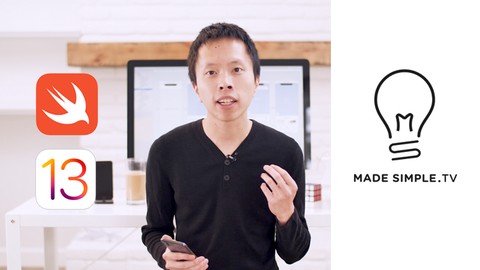
Learn and Understand Building Modern iOS Apps
Learn and Understand Building Modern iOS Apps, available at $89.99, has an average rating of 4.2, with 162 lectures, based on 230 reviews, and has 1942 subscribers.
You will learn about Master programming fundamentals – no previous experience needed! Understand how to build quality iOS apps that sell on the App Store Leverage the powerful Xcode 11 IDE to write code more quickly Use popular industry design patterns, ensuring you'll write quality code Structure your code for reuse using Object Oriented Programming Clone the core feature set of two top iOS Apps – Lyft and Spotify Build proficiency with Swift 5.0 programming language This course is ideal for individuals who are People who have an app idea and want to build the app of their dreams or Engineers who want to learn iOS development or People who are looking for a career switch into iOS development It is particularly useful for People who have an app idea and want to build the app of their dreams or Engineers who want to learn iOS development or People who are looking for a career switch into iOS development.
Enroll now: Learn and Understand Building Modern iOS Apps
Summary
Title: Learn and Understand Building Modern iOS Apps
Price: $89.99
Average Rating: 4.2
Number of Lectures: 162
Number of Published Lectures: 162
Number of Curriculum Items: 162
Number of Published Curriculum Objects: 162
Original Price: $199.99
Quality Status: approved
Status: Live
What You Will Learn
- Master programming fundamentals – no previous experience needed!
- Understand how to build quality iOS apps that sell on the App Store
- Leverage the powerful Xcode 11 IDE to write code more quickly
- Use popular industry design patterns, ensuring you'll write quality code
- Structure your code for reuse using Object Oriented Programming
- Clone the core feature set of two top iOS Apps – Lyft and Spotify
- Build proficiency with Swift 5.0 programming language
Who Should Attend
- People who have an app idea and want to build the app of their dreams
- Engineers who want to learn iOS development
- People who are looking for a career switch into iOS development
Target Audiences
- People who have an app idea and want to build the app of their dreams
- Engineers who want to learn iOS development
- People who are looking for a career switch into iOS development
This course is carefully designed to take someone with either no programming or iOS experience, and teach them exactly what it takes to build an app. You’ll learn how to build modern iOS apps by building the core features of two iconic apps of our time: Lyft and Spotify.
I’ve taken the best of my material and experience of 5+ years of teaching at University of Southern California and General Assembly, and packaging it together in this course, just for you.
UIKit vs SwiftUI
This course will be covering UIKit over SwiftUI for several reasons:
-
UIKit is undeniably the predominate framework used by Fortune 500 and tech companies. If you’re looking for an iOS career or you’re working with an existing codebase, virtually all of these iOS apps will be UIKit driven. We are comparing a technology with over a decade of history (UIKit) vs one that was introduced in less than a year (SwiftUI).
-
SwiftUI has a steeper learning curve, less documentation, and significantly smaller community size. Apple’s SwiftUI documentation is limited at best. Many developers have been writing books, articles, and tutorials on SwiftUI. But at this time, everyone is a beginner and no one is an expert. There’s much less SwiftUI learning material and much more open issues / unanswered questions than UIKit.
-
SwiftUI needs much more time to mature. From interviewing iOS engineers I know who’s worked directly with SwiftUI at production level, it isn’t a technology that’s ready for primetime and has several limitations (i.e. limited catalogue of view components, no custom view extensions, etc.). This takes time for Apple engineers to introduce updates and bug fixes.
SwiftUI is currently at a place where it’s not easy for beginners, and not ready for professionals. For those reasons, this course offers a much more widely used, stable, and easier to develop with technology.
Zero Risk
This course comes with a full 30 day money-back guarantee. Meaning if you are not completely satisfied with the course or your progress, simply let me know and I’ll refund you 100%, every last penny no questions asked.
You either end up with iOS skills, go on to develop great apps and potentially make an awesome career for yourself, or you try the course and simply get all your money back if you don’t like it…
Ready to get started?
Enroll nowusing the “Add to Cart” button on the right, and get started on your way to creative, advanced Java brilliance. Or, take this course for a free spin using the preview feature, so you know you’re 100% certain this course is for you.
Course Curriculum
Chapter 1: Getting Started
Lecture 1: Welcome!
Lecture 2: Course Roadmap
Lecture 3: Project Files
Lecture 4: Project Files – Link
Chapter 2: Installation and Walkthrough of Xcode
Lecture 1: Introduction
Lecture 2: Integrated Development Environments
Lecture 3: Setup
Lecture 4: Walkthrough
Chapter 3: Two Ways to Run and Test Your iOS App
Lecture 1: Introduction
Lecture 2: Simulator
Lecture 3: Device
Lecture 4: Simulator vs Device
Chapter 4: Fundamentals of User Interfaces
Lecture 1: Introduction
Lecture 2: Fundamentals
Lecture 3: Coordinate System and Views
Lecture 4: UIKit
Lecture 5: Interface Builder
Lecture 6: Images
Lecture 7: Images – Demo
Lecture 8: App Icon
Chapter 5: Responsive Design with Auto Layout
Lecture 1: Introduction
Lecture 2: View Relationships
Lecture 3: Origins
Lecture 4: Constraints
Lecture 5: Spacing and Dimension
Lecture 6: Alignment and Aspect Ratio
Chapter 6: Understanding Swift Fundamentals
Lecture 1: Introduction
Lecture 2: Overview
Lecture 3: Data Types
Lecture 4: Constants and Variables
Lecture 5: Reserved Words
Lecture 6: Operators
Lecture 7: Operators Demo
Lecture 8: String Interpolation
Lecture 9: Control Flow
Lecture 10: If Else
Lecture 11: Switch
Lecture 12: Print
Lecture 13: Loops
Lecture 14: Functions
Chapter 7: Exploring Object Oriented Programming
Lecture 1: Introduction
Lecture 2: Object Oriented Programming
Lecture 3: Class
Lecture 4: Objects
Lecture 5: Scope
Lecture 6: Inheritance
Chapter 8: Connecting Interface with Code
Lecture 1: Introduction
Lecture 2: View Controller
Lecture 3: Optional Pt. 1
Lecture 4: Optional Pt. 2
Lecture 5: Outlets / Actions
Lecture 6: Enumeration
Lecture 7: Mad Libs Introduction
Lecture 8: Setting Up The Interface
Lecture 9: Exploring Apple Developer Documentation
Lecture 10: Connecting Outlets
Lecture 11: Connecting Actions
Lecture 12: Creating The Story
Lecture 13: Alert Controller
Chapter 9: Working with Design Patterns
Lecture 1: Introduction
Lecture 2: Model View Controller
Lecture 3: Type Properties
Lecture 4: Singleton
Lecture 5: Protocol
Lecture 6: Delegation
Chapter 10: Building Reminders
Lecture 1: Introduction
Lecture 2: Array
Lecture 3: Error Handling
Lecture 4: Type Casting
Lecture 5: Codable API
Lecture 6: Tableview Introduction
Lecture 7: Tableview In Practice
Lecture 8: Tableview – Custom Cells
Lecture 9: Segue
Lecture 10: View Controller Lifecycle
Lecture 11: Data Persistence Introduction
Lecture 12: Data Persistence – User Defaults
Lecture 13: Data Persistence – File System
Lecture 14: App Overview
Lecture 15: Defining the Model
Lecture 16: Laying Out the Interface
Lecture 17: Building RemindersViewController
Lecture 18: Building FavoriteReminderViewController
Lecture 19: Building NewReminderViewController
Lecture 20: Toggling Completed Status
Lecture 21: Removing Reminders
Lecture 22: Passing Information Through Segues
Lecture 23: Saving and Loading Reminders
Chapter 11: Properly Debug and Troubleshoot Issues
Lecture 1: Introduction
Instructors
-
Bennett Lee
Lead Engineer, University Lecturer
Rating Distribution
- 1 stars: 5 votes
- 2 stars: 2 votes
- 3 stars: 10 votes
- 4 stars: 40 votes
- 5 stars: 173 votes
Frequently Asked Questions
How long do I have access to the course materials?
You can view and review the lecture materials indefinitely, like an on-demand channel.
Can I take my courses with me wherever I go?
Definitely! If you have an internet connection, courses on Udemy are available on any device at any time. If you don’t have an internet connection, some instructors also let their students download course lectures. That’s up to the instructor though, so make sure you get on their good side!
You may also like
- Top 10 Financial Technology Courses to Learn in December 2024
- Top 10 Agile Methodologies Courses to Learn in December 2024
- Top 10 Project Management Courses to Learn in December 2024
- Top 10 Leadership Skills Courses to Learn in December 2024
- Top 10 Public Speaking Courses to Learn in December 2024
- Top 10 Affiliate Marketing Courses to Learn in December 2024
- Top 10 Email Marketing Courses to Learn in December 2024
- Top 10 Social Media Management Courses to Learn in December 2024
- Top 10 SEO Optimization Courses to Learn in December 2024
- Top 10 Content Creation Courses to Learn in December 2024
- Top 10 Game Development Courses to Learn in December 2024
- Top 10 Software Testing Courses to Learn in December 2024
- Top 10 Big Data Courses to Learn in December 2024
- Top 10 Internet Of Things Courses to Learn in December 2024
- Top 10 Quantum Computing Courses to Learn in December 2024
- Top 10 Cloud Computing Courses to Learn in December 2024
- Top 10 3d Modeling Courses to Learn in December 2024
- Top 10 Mobile App Development Courses to Learn in December 2024
- Top 10 Graphic Design Courses to Learn in December 2024
- Top 10 Videography Courses to Learn in December 2024






















